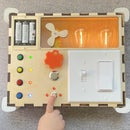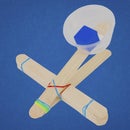Introduction: Rubber Band Helicopters - Engineering Projects for Kids
The rubber band-powered helicopter is a favorite of my students because of the ease of construction and the exciting end product!
You can find the lesson plan, 1-page project sheet, and more project ideas at STEM-Inventions.com
How It Works:
1. Energy is stored in the sport rubber by winding the propeller.
2. When flown, the sport rubber rapidly releases its energy by unwinding, which turns both the propeller blade and the paper cutout.
3. The paper cutout pushes against the surrounding air, which creates horizontal air resistance, or drag. This makes it harder for the cutout to spin. Because the cutout does not spin as easily, more energy from the sport rubber is released into the propeller, which is much easier to turn. In this way, the paper acts like the rear rotor of a real helicopter
4. As the propeller spins rapidly, it begins to create lift by pushing air downward. With enough energy, the helicopter will fly in whatever direction it is pointing.
Supplies
You can find an entire kit of materials here: Rubber Band Helicopter Kit
The Engineering Creation Kit has everything you need for this project and many more from STEM Inventions.
Or purchase tools and materials individually:
- Plastic propellers (Larger Pack)
- Craft sticks
- Paperclips
- 2 Rubber bands
- Card stock
- Masking tape (Dispenser)
- Scissors
When you make a purchase through these links, I may earn an affiliate commission at zero cost to you.
Step 1: Tips and Troubleshooting
- The number one reason helicopters fail to fly is due to simply not winding the rubber band enough.
- The second biggest reason is caused by letting go of the whole helicopter at once. When I show students how to fly the helicopter, I say, "Let go - let go," as I release the top and bottom. Tell your students that verbalizing "Let go - let go" in one's head or out loud can help coordinate one's hands.
- You may want to tie the sport rubber for younger students during your prep time.
- Try making templates of bird wings or a helicopter silhouette. For one Halloween, I made cardboard templates of bats. For added flair, the project was renamed "Baticopters."
- In my experience, a long rectangle approximately 6" x 1.5" made out of card stock is the most efficient shape and material.
- Cutouts which span less than 3" typically do not perform well.
- With a little practice, students can throw the helicopter as it is being released for additional height
- Spinning propellers can get caught in long hair.
- Stay far away from buildings, trees and fences!

Finalist in the
The Teacher Contest

Participated in the
Toy Challenge 2











